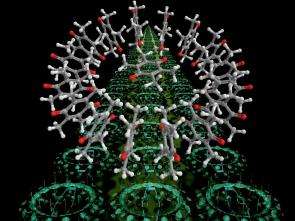March 12, 2008 weblog
Tiny Brain-Like Transistor Controls Nanobots

For years, researchers have been building tiny nanobots that could one day serve a variety of purposes. But, until now, nanobots couldn't work together.
Recently, scientists Anirban Bandyopadhyay and Somobrata Acharya from the National Institute of Materials Science in Tsukuba, Japan, have built the first ultra-tiny, ultra-powerful "brains" for nanobots.
The brains - just two billionths of a meter across - act as tiny computer transistors. But instead of carrying out just one operation at a time, like a normal transistor, the new devices can simultaneously perform 16 operations at once. In other words, the devices use parallel processing - like the human brain - rather than serial processing - like a normal computer. The researchers call this ability "one-to-many" communication.
The tiny machines are composed of 17 duroquinone molecules that act as logic gates. The researchers arranged 16 of these molecules in a wheel, and placed the last molecule in the middle, which acts as the control center. The entire wheel was constructed on a gold substrate.
Each duroquinone molecule has four side chains that can be independently rotated to represent four separate logic states. Conventional transistors, on the other, have just two logic states: on and off.
To operate the device, the researchers poked the center duroquinone molecule with electrical pulses from the tip of a scanning tunneling microscope. The center molecule is linked to the surrounding 16 molecules by weak hydrogen bonds, so that a pulse to the center molecule can simultaneously transmit instructions to each of the surrounding molecules.
Since each molecule has four side chains, a single pulse to the center molecule can produce one of nearly 4.3 billion (4^16) different states. That compares with a total of 2 (2^1) states that can be produced in a conventional transistor. However, some instructions from the center molecule result in particular arrays of molecules that take on fixed states to maintain equilibrium. But, in principle, the system has 4.3 billion possible states.
Banyopadhyay and Acharya aren´t stopping there, though. The team plans to turn the 2D wheel of 16 molecules into a 3D sphere - a structure that would consist of 1,024 molecules. This spherical device could perform 1,024 instructions at once, theoretically making it capable of 4^1024 different states. The center molecule could be controlled with "handles" that stick out of the core.
The researchers also tested out the 2D nano-brain in their study. They attached the device to eight nanobots (sometimes called "molecular machines"), and demonstrated that the nanobots could respond simultaneously to a single instruction. The ´bots could work together, as if part of a tiny factory.
The scientists also created the "world´s tiniest elevator," a 2-nanometer-tall device that can move up and down by 1 nanometer. They also plan to hook up the brain to a variety of nano-sized motors, propellers, switches, and sensors for different applications.
In the future, the researchers hope that they can control the central duroquinone molecule using proteins or other molecules, rather than the scanning electron microscope tip. For one thing, this ability might enable the brains to serve as tiny transistors packed onto a microchip for future powerful computers.
More futuristically, the brains could accompany nanobots for medical missions, such as bloodless surgery. As the scientists explain, specialized molecular machines could travel through veins to a tumor or damaged tissue, and perform surgery according to the instructions given by the new brains.
More information: Bandyopadhyay, Anirban and Acharya, Somobrata. "A 16-bit parallel processing in a molecular assembly." Proceedings of the National Academy of Sciences. March 11, 2008, vol. 105, no. 10, 3668-3672.
via: The Telegraph





















